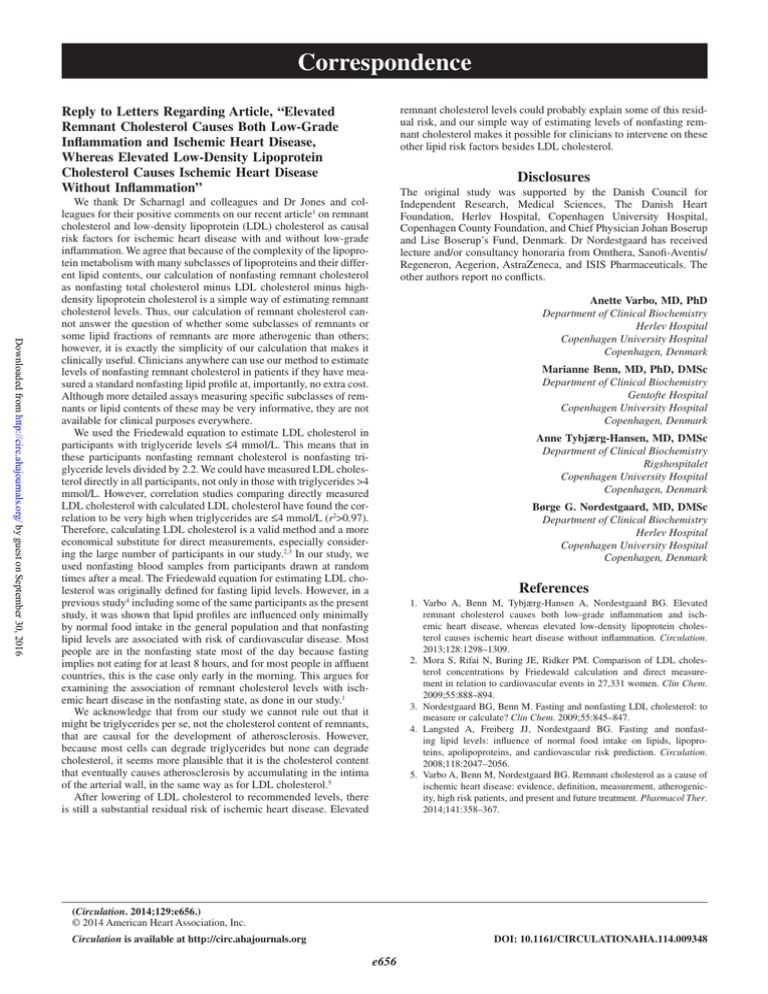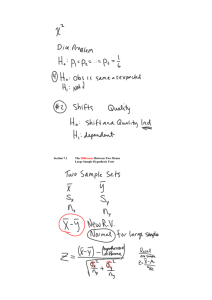
Correspondence
Article Type
Reply to Letters Regarding Article, “Elevated
Remnant Cholesterol Causes Both Low-Grade
Inflammation and Ischemic Heart Disease,
Whereas Elevated Low-Density Lipoprotein
Cholesterol Causes Ischemic Heart Disease
Without Inflammation”
remnant cholesterol levels could probably explain some of this residual risk, and our simple way of estimating levels of nonfasting remnant cholesterol makes it possible for clinicians to intervene on these
other lipid risk factors besides LDL cholesterol.
Disclosures
The original study was supported by the Danish Council for
Independent Research, Medical Sciences, The Danish Heart
Foundation, Herlev Hospital, Copenhagen University Hospital,
Copenhagen County Foundation, and Chief Physician Johan Boserup
and Lise Boserup’s Fund, Denmark. Dr Nordestgaard has received
lecture and/or consultancy honoraria from Omthera, Sanofi-Aventis/
Regeneron, Aegerion, AstraZeneca, and ISIS Pharmaceuticals. The
other authors report no conflicts.
Downloaded from http://circ.ahajournals.org/ by guest on September 30, 2016
We thank Dr Scharnagl and colleagues and Dr Jones and colleagues for their positive comments on our recent article1 on remnant
cholesterol and low-density lipoprotein (LDL) cholesterol as causal
risk factors for ischemic heart disease with and without low-grade
inflammation. We agree that because of the complexity of the lipoprotein metabolism with many subclasses of lipoproteins and their different lipid contents, our calculation of nonfasting remnant cholesterol
as nonfasting total cholesterol minus LDL cholesterol minus highdensity lipoprotein cholesterol is a simple way of estimating remnant
cholesterol levels. Thus, our calculation of remnant cholesterol cannot answer the question of whether some subclasses of remnants or
some lipid fractions of remnants are more atherogenic than others;
however, it is exactly the simplicity of our calculation that makes it
clinically useful. Clinicians anywhere can use our method to estimate
levels of nonfasting remnant cholesterol in patients if they have measured a standard nonfasting lipid profile at, importantly, no extra cost.
Although more detailed assays measuring specific subclasses of remnants or lipid contents of these may be very informative, they are not
available for clinical purposes everywhere.
We used the Friedewald equation to estimate LDL cholesterol in
participants with triglyceride levels ≤4 mmol/L. This means that in
these participants nonfasting remnant cholesterol is nonfasting triglyceride levels divided by 2.2. We could have measured LDL cholesterol directly in all participants, not only in those with triglycerides >4
mmol/L. However, correlation studies comparing directly measured
LDL cholesterol with calculated LDL cholesterol have found the correlation to be very high when triglycerides are ≤4 mmol/L (r2>0.97).
Therefore, calculating LDL cholesterol is a valid method and a more
economical substitute for direct measurements, especially considering the large number of participants in our study.2,3 In our study, we
used nonfasting blood samples from participants drawn at random
times after a meal. The Friedewald equation for estimating LDL cholesterol was originally defined for fasting lipid levels. However, in a
previous study4 including some of the same participants as the present
study, it was shown that lipid profiles are influenced only minimally
by normal food intake in the general population and that nonfasting
lipid levels are associated with risk of cardiovascular disease. Most
people are in the nonfasting state most of the day because fasting
implies not eating for at least 8 hours, and for most people in affluent
countries, this is the case only early in the morning. This argues for
examining the association of remnant cholesterol levels with ischemic heart disease in the nonfasting state, as done in our study.1
We acknowledge that from our study we cannot rule out that it
might be triglycerides per se, not the cholesterol content of remnants,
that are causal for the development of atherosclerosis. However,
because most cells can degrade triglycerides but none can degrade
cholesterol, it seems more plausible that it is the cholesterol content
that eventually causes atherosclerosis by accumulating in the intima
of the arterial wall, in the same way as for LDL cholesterol.5
After lowering of LDL cholesterol to recommended levels, there
is still a substantial residual risk of ischemic heart disease. Elevated
Anette Varbo, MD, PhD
Department of Clinical Biochemistry
Herlev Hospital
Copenhagen University Hospital
Copenhagen, Denmark
Marianne Benn, MD, PhD, DMSc
Department of Clinical Biochemistry
Gentofte Hospital
Copenhagen University Hospital
Copenhagen, Denmark
Anne Tybjærg-Hansen, MD, DMSc
Department of Clinical Biochemistry
Rigshospitalet
Copenhagen University Hospital
Copenhagen, Denmark
Børge G. Nordestgaard, MD, DMSc
Department of Clinical Biochemistry
Herlev Hospital
Copenhagen University Hospital
Copenhagen, Denmark
References
1.Varbo A, Benn M, Tybjærg-Hansen A, Nordestgaard BG. Elevated
remnant cholesterol causes both low-grade inflammation and ischemic heart disease, whereas elevated low-density lipoprotein cholesterol causes ischemic heart disease without inflammation. Circulation.
2013;128:1298–1309.
2. Mora S, Rifai N, Buring JE, Ridker PM. Comparison of LDL cholesterol concentrations by Friedewald calculation and direct measurement in relation to cardiovascular events in 27,331 women. Clin Chem.
2009;55:888–894.
3. Nordestgaard BG, Benn M. Fasting and nonfasting LDL cholesterol: to
measure or calculate? Clin Chem. 2009;55:845–847.
4.Langsted A, Freiberg JJ, Nordestgaard BG. Fasting and nonfasting lipid levels: influence of normal food intake on lipids, lipoproteins, apolipoproteins, and cardiovascular risk prediction. Circulation.
2008;118:2047–2056.
5. Varbo A, Benn M, Nordestgaard BG. Remnant cholesterol as a cause of
ischemic heart disease: evidence, definition, measurement, atherogenicity, high risk patients, and present and future treatment. Pharmacol Ther.
2014;141:358–367.
(Circulation. 2014;129:e656.)
© 2014 American Heart Association, Inc.
Circulation is available at http://circ.ahajournals.org
DOI: 10.1161/CIRCULATIONAHA.114.009348
e656
Reply to Letters Regarding Article, ''Elevated Remnant Cholesterol Causes Both
Low-Grade Inflammation and Ischemic Heart Disease, Whereas Elevated Low-Density
Lipoprotein Cholesterol Causes Ischemic Heart Disease Without Inflammation''
Anette Varbo, Marianne Benn, Anne Tybjærg-Hansen and Børge G. Nordestgaard
Downloaded from http://circ.ahajournals.org/ by guest on September 30, 2016
Circulation. 2014;129:e656
doi: 10.1161/CIRCULATIONAHA.114.009348
Circulation is published by the American Heart Association, 7272 Greenville Avenue, Dallas, TX 75231
Copyright © 2014 American Heart Association, Inc. All rights reserved.
Print ISSN: 0009-7322. Online ISSN: 1524-4539
The online version of this article, along with updated information and services, is located on the
World Wide Web at:
http://circ.ahajournals.org/content/129/24/e656
Permissions: Requests for permissions to reproduce figures, tables, or portions of articles originally published
in Circulation can be obtained via RightsLink, a service of the Copyright Clearance Center, not the Editorial
Office. Once the online version of the published article for which permission is being requested is located,
click Request Permissions in the middle column of the Web page under Services. Further information about
this process is available in the Permissions and Rights Question and Answer document.
Reprints: Information about reprints can be found online at:
http://www.lww.com/reprints
Subscriptions: Information about subscribing to Circulation is online at:
http://circ.ahajournals.org//subscriptions/

